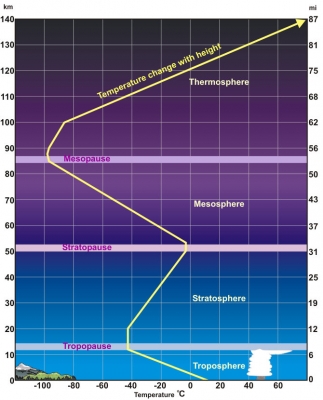
|
The atmosphere, with all its layers, extends up to 10,000 km from Earth’s surface. Temperatures vary in the different layers: the mesosphere can go down to -90 °C, the exosphere much, much lower, whereas the thermosphere can be as hot as 2000 °C! |
Temperature varies greatly at different heights relative to Earth’s surface and this variation in temperature characterizes the four layers that exist in the atmosphere. These layers include the troposphere, stratosphere, mesosphere, and thermosphere.
The troposphere is the lowest of the four layers, extending from the surface of the Earth to about 11 km (6.8 mi) into the atmosphere where the tropopause (the boundary between the troposphere stratosphere) is located. The width of the troposphere can vary depending on latitude, for example, the troposphere is thicker in the tropics (about 16 km (9.9 mi)) because the tropics are generally warmer, and thinner at the poles (about 8 km (5.0 mi)) because the poles are colder. Temperatures in the atmosphere decrease with height at an average rate of 6,5°C (11,7 °F) per kilometer. Because the troposphere experiences its warmest temperatures closer to Earth’s surface, there is great vertical movement of heat and water vapour, causing turbulence. This turbulence, in conjunction with the presence of water vapour, is the reason that weather occurs within the troposphere.
Following the tropopause is the stratosphere. This layer extends from the tropopause to the stratopause which is located at an altitude of about 50 km (31 mi). Temperatures remain constant with height from the tropopause to an altitude of 20 km (12 mi), after which they start to increase with height. This happening is referred to as an inversion and it is because of this inversion that the stratosphere is not characterized as turbulent. The stratosphere receives its warmth from the sun and the ozone layer which absorbs ultraviolet radiation.
The next layer is called the mesosphere which extends from the stratopause to the mesopause, located at an altitude of 85 km (53 mi). Temperatures in the mesospere decrease with altitude and are in fact the coldest in the Earth’s atmosphere.This decrease in temperature can be attributed to the diminishing radiation received from the Sun, after most of it has already been absorbed by the thermosphere.
The fourth layer of the atmosphere is known as the thermosphere which extends from the mesopause to the ‘top’ of the collisional atmosphere. Some of the warmest temperatures can be found in the thermosphere, due to its reception of strong ionizing radiation at the level of the Van Allen radiation belt.
Credit: Wikipedia
Picture credit: Google




